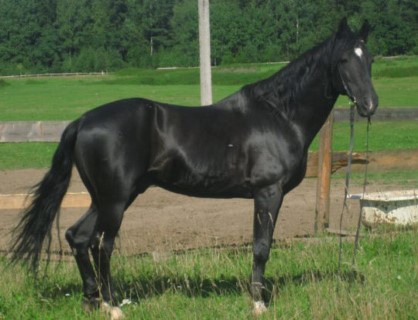Karachay (also known as Karakachan Pony, Karatschai Pony,
Karatschaever, Karatschaewsker, orKarachaier) horses were developed in the
Northern Caucasus. They came from the highland Karachay at the rise of Kuban.
They were developed by crossing regional horses with eastern stallions.
Karachay horses are summered in rugged mountain country where there are large
changes in temperature and humidity, and wintered in the foothill and plains
with some hay feeding. These conditions made the Karachay horse strong-limbed
and sturdy.
They were first bred for use in the military and agriculture
use. They were bred by Karachays around the 14th-15th centuries in the climatic
and geographical conditions of the North Caucasus. They were known to Europeans
since the 18th century at least. German researcher P. Pallas (1793) wrote:
"They grow a small but hardy and hot breed of horses, known for their
outstanding qualities". Another researcher, Bronevsky S. (1823), wrote:
"They have small, but sturdy breed of mountain horses, known under the
name of Karachay horses". Hungarian ethnographer, a member of the
expedition of Emmanuel to Elbrus, Jean-Charles de Besse also gave a high
evaluation of the breed in 1829: "Karachays ranch fine breed of horses...
They are easy on the go and I don't know any other horse breed that is better
for ridding on steep slopes and which is so inexhaustible".
At the end of the 19th century there were local stud farms
in Karachay where some herds included 500-1000 horses. In the beginning of the
20th century Karachay played a significant role, supplying most of the Kuban
Cossack army`s regiments with chargers. Every year Karachay sold about 10 thousands
of horses.
In the 1920’s, during the period of recreation of horse
breeding at North Caucasus which took place after the destroying civil war,
people worked with Karachay horses according. In line with this, selective
breeding of Karachay horses ensued. The Riding State Stud farm was created in
1927, and the State stud farm (Gosplemhoz) of Karachay horses was organized in
1929 and then reorganized in 1930 into Karachaevsky stud farm No 168, which
bore Josephe Stalin`s name for some time.
In 1935 the first volume of the studbook was established for
the mountain breeds, registering 204 Karachay mares. Karachay horse were
especially good in the mountains. In the winter of 1935/ 1936 a 3,000-kilometer
ride was held in the Caucasus. The time and route of the ride were extremely
difficult. Among the participants there were 10 Karachay horse and horses of
other breeds. The ride lasted 47 days, on average 64 km per day. In one month
the same horses finished a race from Piatigorsk to Rostov, distance of 600 km
in five days over very muddy roads/trails. In 1937 a State breeding center was
created in Karachay Autonomous Oblast.
In 1943 Joseph Stalin deported the Karachays people to
Central Asia and the Karachay breed was renamed as the Kabarda breed and the
two breeds were combined. But the horses still were bred in the same lands.
After the war they bred a new type of horses, higher and more sturdy. Karachay
horses were exported to other stud farms, e.g. for recreation of Malkinsky stud
farm No 34 which began in 1958. There were exported 104 Karachay and
Anglo-Karachay mares and 4 stallions from the stud farm No 168. Names
"Karachay horse" and "Anglo-Karachay horse" were mentioned
again in specialist literature in 1963, but the breed still wasn't separate.
Karachay horses were automatically referred to the Kabarda breed and so named
in the 2-nd, 3-rd and 4-th volumes of the studbooks. In 1980s the
discriminatory decision of referring Karachay horse to Kabarda breed was
annulled and Karachay breed was again separate included into the 5-th volume of
State stud book. Karachay breed and Anglo-Karachay breed group regained their
due place being mentioned in the State stud books and official lists of species
of the USSR and Russia in 1990s.
In 1998 a group of Karachay-Cherkessiya`s horsemen with
three Karachay horses ascended the east top of the mountain Elbrus, making an
unprecedented act. In 1999 the horsemen ascended west top of the highest
mountain in Europe. The Karachay horses’ is thus strong with strong and adapted
limbs to climbing mountains. Special credit goes to an expert on horse breeding
named Klych Geriy Urusov who was the mastermind of Elbrus conquest on
horseback. At the present time Karachay horse is bred at Karachaevsky
(Malokarachaevski) stud farm No 168 and the other stud farms. In 2008, there
were about 20 000 horses in Karachaevo-Cherkessiya.
